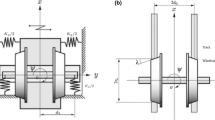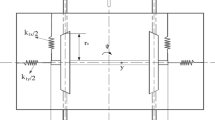Abstract
The effect of the nonlinear terms on bifurcation behaviors of limit cycles of a simplified railway wheelset model is investigated. At first, the stable equilibrium state loses its stability via a Hopf bifurcation. The bifurcation curve is divided into a supercritical branch and a subcritical one by a generalized Hopf point, which plays a key role in determining the occurrence of flange contact and derailment of high-speed railway vehicles, and the occurrence of this critical situation is an important decision-making criteria for design parameters. Secondly, bifurcations of limit cycles are discussed by comparing the bifurcation behavior of cycles for two different nonlinear parameters. Unlike local Hopf bifurcation analysis based on a single bifurcation parameter in most papers, global bifurcation analysis of limit cycles based on two bifurcation parameters is investigated, simultaneously. It is shown that changing nonlinear parameter terms can affect bifurcation types of cycles and division of parameter domains. In particular, near the branch points of cycles, two symmetrical limit cycles are created by a pitchfork bifurcation and then two symmetrical cycles both undergo a period-doubling bifurcation to form two stable period-two cycles. Around the resonant points, period orbits can make several turns, whose number of turns corresponds to the ratio of resonance. Thirdly, near the Neimark–Sacker bifurcation of cycles, a stable torus is created by a supercritical Neimark–Sacker bifurcation, which shows that the orbit of the model exhibits modulated oscillations with two frequencies near the limit cycle. These results demonstrate that nonlinear parameter terms can produce very complex global bifurcation phenomena and make obvious effects on possible hunting motions even though a simple railway wheelset model is concerned.








Similar content being viewed by others
References
Wickens, A.H.: Fundamentals of Rail Vehicle Dynamics: Guidance and Stability. Swets & Zeitlinger Publishers, Lisse (2003)
Nath, Y., Jayadev, K.: Influence of yaw stiffness on the nonlinear dynamics of railway wheelset. Commun. Nonlinear Sci. Numer. Simul. 10(2), 179–190 (2005)
Polach, O., Kaiser, I.: Comparison of methods analyzing bifurcation and hunting of complex rail vehicle models. J. Comput. Nonlinear Dyn. 7(10), 614–620 (2012)
Jin, X.S., Wu, P.B., Wen, Z.F.: Effects of structure elastic deformations of wheelset and track on creep forces of wheel/rail in rolling contact. Wear 253(1–2), 247–256 (2002)
Koo, J.S., Choi, S.Y.: Theoretical development of a simplified wheelset model to evaluate collision-induced derailments of rolling stock. J. Sound Vib. 331(13), 3172–3198 (2012)
Ahmadian, M., Yang, S.P.: Hopf bifurcation and hunting behavior in a rail wheelset with flange contact. Nonlinear Dyn. 15(1), 15–30 (1997)
Sedighi, H.M., Shirazi, K.H.: Bifurcation analysis in hunting dynamical behavior in a railway bogie: using novel exact equivalent functions for discontinuous nonlinearities. Sci. Iran. 19(6), 1493–1501 (2012)
Dong, H., Zeng, J., Xie, J.H., Jia, L.: Bifurcation instability forms of high speed railway vehicles. Sci. China Technol. Sci. 56(7), 1685–1696 (2013)
Zhang, T.T., Dai, H.Y.: Bifurcation analysis of high-speed railway wheel-set. Nonlinear Dyn. 83(3), 1511–1528 (2016)
Yan, Y., Zeng, J.: Hopf bifurcation analysis of railway bogie. Nonlinear Dyn. (2017). https://doi.org/10.1007/s11071-017-3634-7
Yabuno, H., Okamoto, T., Aoshima, N.: Stabilization control for the hunting motion of a railway wheelset. Veh. Syst. Dyn. 35, 41–55 (2001)
True, H.: Dynamics of a rolling wheelset. Appl. Mech. Rev. 46, 438–444 (1993)
Wickens, A.H.: The dynamics stability of a simplified four-wheel railway vehicle having profiled wheels. Int. J. Solids Struct. 1, 385–406 (1965)
Xu, G., Troger, H., Steindl, A.: Global analysis of the loss of stability of a special railway body. In: Schiehlen, W. (ed.) Nonlinear Dynamics in Engineering Systems, pp. 345–352. Springer, Berlin (1990)
Yabuno, H., Okamoto, T., Aoshima, N.: Effect of lateral linear stiffness on nonlinear characteristics of hunting motion of a railway wheelset. Meccanica 37(6), 555–568 (2002)
Perko, L.: Differential Equations and Dynamical Systems, 3rd edn. Springer, New York (2001)
Kuznetsov, Y.A.: Elements of Applied Bifurcation Theory, 3rd edn. Springer, New York (2004)
Dhooge, A., Govaerts, W., Kuznetsov, Y.A.: MATCONT: a MATLAB package for numerical bifurcation analysis of ODEs. ACM Trans. Math. Softw. 9(2), 141–164 (2003)
Acknowledgements
This work is supported by the State Key Laboratory of Rail Traffic Control and Safety (No. RCS2017K002), Beijing Jiaotong University and the Natural Science Foundation of China (NSFC) under Project No. 11171017.
Author information
Authors and Affiliations
Corresponding author
Ethics declarations
Conflict of interest
The authors declare that there are no conflicts of interest regarding the publication of this manuscript.
Appendix
Appendix
Rights and permissions
About this article
Cite this article
Cheng, L., Wei, X. & Cao, H. Two-parameter bifurcation analysis of limit cycles of a simplified railway wheelset model. Nonlinear Dyn 93, 2415–2431 (2018). https://doi.org/10.1007/s11071-018-4333-8
Received:
Accepted:
Published:
Issue Date:
DOI: https://doi.org/10.1007/s11071-018-4333-8




